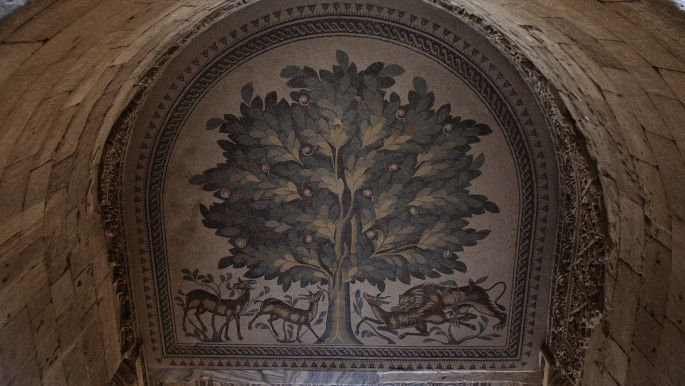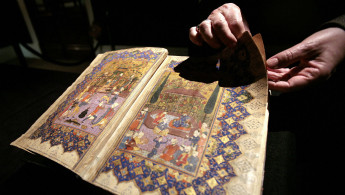Images and idols: the figurative in Islamic art
Working as a curator of Islamic art, I was frequently faced with challenging questions from the general public. Many of these were beyond my scope as an art historian, or too broad to cover during a brief tour - who was Muhammad? what is Shiism? what is the Quran about? - but, of the ones to do with artistic production in the Islamic world, one stood out in its regularity. Aren't pictures of living things banned in Islam?
Looking around the museum galleries, and indeed at almost any collection of Islamic art, the simple answer is clear - no. Poets peer out from illustrated manuscripts; languid aristocrats are woven into silk panels; mounted falconers chase their quarry across ceramics, metalwork, and carved stone. It is undeniable that from the earliest period until the present day, figural representation has played an important role in the arts of the Islamic world.
Scriptural prohibition?
If this is the case, you may reasonably ask, then where has the notion of Islam as prohibiting images - being aniconic, to use the technical term - come from? The Quran itself does not explicitly forbid the making of images, but it is unequivocal in its condemnation of idols and idolatry.
It is in the Hadith (the Traditions of the Prophet) that specific mention is made of a distaste for figural imagery. In these records of the life and sayings of Muhammad, there are mentions of his commanding that curtains with human figures on them be cut up and turned into cushion covers, of painters being called upon to breathe life into their creations on the Day of Judgement, and generally an aversion towards representations of humans and animals.
 |
Different schools of thought, and differing regional styles and tastes, have led to varying approaches to figural art in the Islamic world. |  |
For those who would choose to characterise Islam as unique among the Abrahamic faiths in this respect, it is worth mentioning that it is emphatically not. Judaism explicitly forbids the creation of "graven images" in the Ten Commandments, and Christianity has had a history of violent iconoclasm in both the Orthodox east (particularly during the 8th century) and the Latin west (such as the Puritan image-breaking of the English Civil War).
Given that there is no specific Quranic injunction against figural imagery, provided that such images are not worshipped as idols, the depiction of human and animal figures has been subject to discussion since the earliest Islamic period. Different schools of thought, and differing regional styles and tastes, have led to varying approaches to figural art in the Islamic world.
As the 16th century Persian calligrapher, painter and art historian Dost Muhammad wrote in a preface to a royal album of calligraphy and paintings, in spite of religious disapproval of figural imagery, "the garden of painting and illumination is an orchard of perfect adornment… and the portraitist's conscience need not be pricked by the thorns of despair".
From the early 630s onwards, Arab armies spread out of the Arabian Peninsula and proceeded to conquer Syria and Egypt, former heartlands of the Byzantine Empire, as well as destroying the Sassanian Empire in Iran. As such, the Umayyad Caliphs, who ruled from 661-750, were the heirs to these two great empires of late antiquity, and this was seen in their wholehearted adoption of their use of figural art.
| The Umayyad Mosque in Damascus was built on the site of a Byzantine cathedral [AFP] |
The secular and religious
In the so-called "desert palaces" built in what is now Syria and Jordan, there are frescoes showing rival rulers, mosaics of hunting scenes, and even stucco sculptures - one of which could be a representation of the caliph himself. Such imagery was clearly intended for an entirely secular setting, in which it referenced power, wealth, and leisure.
The emphasis on figural art as a secular, rather than religious, aspect of Islamic art is clearly shown if the desert palaces are contrasted with a much more famous contemporary structure: the Dome of the Rock. This religious structure, completed in 691 under the order of the Caliph Abd al-Malik, clearly references both Byzantine and Sassanian styles in its the decoration, but is entirely devoid of figural imagery.
 |
Some early illustrated manuscripts have had lines drawn across the throats of people illustrated in them, symbolically 'killing' them, and a dish in the British Museum depicting an ibex has been similarly mutilated. |  |
The avoidance of living creatures in the decoration of religious buildings (and indeed religious texts) has generally followed in this vein for the last 1300 years, although there are exceptions to the rule. One such is the shrine of the Sufi sheikh 'Abd al-Samad in Natanz, Iran, built after his death in 1299. The inscription panel features small birds; the heads of many of them have been defaced by later iconoclasts, showing that the taste for figural imagery could wax and wane even within a single geographical area.
This also occurred outside of purely religious settings. Some early illustrated manuscripts have had lines drawn across the throats of people illustrated in them, symbolically "killing" them, and a dish in the British Museum depicting an ibex has been similarly mutilated.
 |
|
| The 'Tree of Life' mosaic at Qasr Hisham, Jericho [AFP] |
Even within a single dynasty, the tastes of a particular ruler, or even a high-ranking member of the court, could decide whether figural imagery was acceptable or not. Under the Mamluks of Egypt and Syria, inlaid metalwork produced before the 1320s bore images of courtly life; thereafter, such images were replaced by inscriptions lauding the ruler or the object's patron, a situation which would generally prevail for the next 200 years. This was largely due to the great Sultan al-Nasir Muhammad, whose taste for inscriptions rather than visuals for self-representation set a non-figural style which would define Mamluk metalwork.
The most obvious use of figural art was as illustration for narratives. The most famous example of this can be found in the Shahnameh, the Persian "Book of Kings", which was composed by the great poet Abu'l-Qasim Firdausi in the late 9th and early 10th century.
This epic story, which tells the history of Persian rulers from mythical beginnings until the Arab conquests, has had paintings integrated into it from at least the 14th century. These help to explain the text and even add drama, bringing a visual aspect to a textual experience. Elsewhere, books of fables, love stories, and advice texts for rulers, whether from Spain, Egypt or India, have all been enlivened by images of the figures who flit through their pages.
Regional variation
In north-west Africa, today's Morocco, Algeria and Tunisia, figural art is found much less commonly than in more easterly Muslim lands. This may reflect local religious attitudes, or pre-Islamic traditions which favoured abstract forms. Historically, the art of these areas has been typified by geometric and floral patterns, whether in manuscripts, textiles, or architectural decoration.
The question of figural representation is a vexed one, and it continues to be disputed and discussed to this day. As with other aspects of Islamic art, what it demonstrates is that the Islamic world is too large, and the period of Islamic history to broad, for any generalisation to ever be entirely true.
Art historian William Greenwood was curator for Central Islamic Lands at the Museum of Islamic Art in Doha, and has also worked in several other areas of the art world - including journalism, auctions, museum consultancy, and lecturing.



